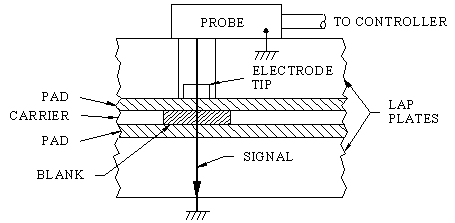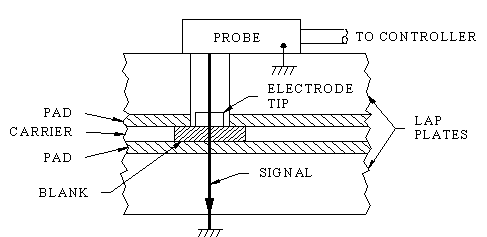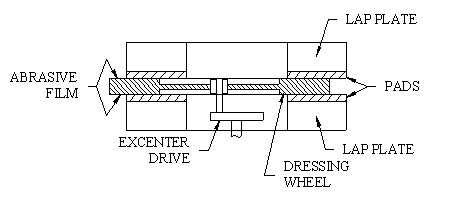
Figure 1
 TRANSAT CORP.
TRANSAT CORP.|
Application Note: Crystal Polishing |
Due to a continuing trend toward crystals of smaller size and higher frequency, there is an increasing need for crystal polishing and for improved polishing methods. Present methods vary widely among different manufacturers and are often a guarded secret. This paper attempts to summarize present methods and to propose improvements in the process.
The reader is advised that the author has no hands-on experience in polishing but instead has had exposure to different manufacturer's processes and discussion with industry experts.
Both planetary and eccentric (pin) lap machines are used. In pin laps, a carrier-normally of thin plastic- holds the blanks between two pad-covered lap plates. It is driven eccentrically and moves the blanks between the plates while a slurry is added. Normally at least one of the plates is stationary.
In planetary laps, carriers-usually metallic-move the blanks in a planetary motion between two lap plates, which are either stationary (in "two-way" laps) or rotating (in "four-way" laps).
The slurry is usually a mixture of cerium oxide and water plus some additives, such as rust inhibitors and lubricants. While cerium is softer than quartz, its mixture with water produces chemical reactions at the quartz surface that aid the polishing action, depending on the pH level of the slurry.
Normally the lap plates are covered with polish pads that could be classified as "soft", "semi-hard", and "hard".
Most soft and semi-hard pads are thin sheets made from synthetic materials such as polyurethane, often perforated with holes and backed by Pressure Sensitive Adhesives (PSA). They provide fast polishing and are less apt to cause surface scratches. However, they are more likely to produce rounding ("rolloff") at the edges, which reduces the effective planparallel area of the crystal.
Hard pads can be metallic but are more often made from hard plastic. Frequently they are relatively thick and inflexible. Generally, hard pads provide the best planparallel polish, but often at reduced polish speed.
There is no general agreement on optimal material properties and surface conditions of polish pads-such as hardness, friction, roughness, "affinity for water" (as mentioned by one reviewer), perforations, grooves, etc. Many users prefer the pad surfaces to be slightly rough or "napped" (as after sanding with fine sandpaper) rather than completely smooth. This prevents "hydroplaning", accelerates polishing, and provides channels for distributing the slurry across the surface.
Periodically the pad surfaces need to be reconditioned. This can be done either INSIDE the polish machine by using "dressing wheels" or OUTSIDE in a separate one-sided lap machine, such as a "Lapmaster". The relative merits of both methods are discussed below.
AUTOMATIC FREQUENCY CONTROL While, nowadays, automatic frequency control is used almost universally in the lapping process, it is still used less frequently in polishing. One reason for this is explained in FIG. 1:

The controller's probe sends a Radio-Frequency (RF) search signal from an electrode through the pad and blank to the probe's ground (REF 1). The signal strength depends on the impedance of the pad (REF 2) . Some pads are insulators that block the signal unless they are either very thin or water absorbent, such that the water slurry can fill the voids and provide a better path for the signal (REF 2).
In some cases it may be necessary to reduce the effective pad impedance by using the arrangement of FIG. 2, in which the electrode protrudes through the pad and the signal travels through only one pad.

Automatic frequency control increases efficiency and yield by eliminating the handling associated with trial-and-error polishing. It can also help to improve quality, as explained below.
PROPOSED POLISHING METHODS
This section proposes to improve polishing through proper choice and use of polish pads.CHOICE OF POLISH PADS
Only those pads are discussed here that are suitable for automatic frequency control.As mentioned before, soft pads tend to provide fast polishing at the expense of planparallelity, while hard pads give good planparallelity at the expense of polish speed. This seems to suggest to use only hard polish pads for polishing and to compensate for the lower speed by automation, such as auto frequency control. This, indeed, appears to be the tendency among leading manufacturers. However, both soft, semi-hard, and hard pads are discussed in the following.
SOFT AND SEMI-HARD PADS
These pads come in thin, flexible sheets-many of them porous or perforated or both, and therefore suitable for frequency control.
Some suitable pads and their suppliers are listed in REF 5.HARD PADS
Most hard pads are relatively thick and nonporous and have a high impedance. They are suitable for automatic frequency control only if their impedance can be lowered enough to allow the RF signal to penetrate the blank.There are several ways to lower the impedance:
For instance a hard pad arrangement per FIG. 1 is acceptable if the pads are thin (approx. 0.5 mm) and perforated with holes. In this case, the water fills the holes and provides the RF conductivity (REF 2).Another suitable hard pad consists of thicker (3-6 mm) plastic mixed with carbon particles, which provide conductivity for the RF signal. This type of "RF conductive pad" has been successfully used for years by a number of manufacturers, based on the arrangement of FIG. 2, with the electrode protruding through the upper pad. Instead of carbon, other conductive particles could be used, such as soft-metal powder.
A third approach is to use nonconductive pads with conductive paths that are local to the area of the signal path. Fig. 3 shows a "conductor ring" imbedded in the lower pad opposite the electrode. The signal flows through the wafer and conductor ring to ground (REF 1).

One way to make such a pad is by using PC board material where the "conductor ring" is a ring of plated-through holes opposite the electrode path. In this application, the electrode must protrude through the other pad ACCORDING TO fig. 2.
In cases where the electrode protrudes through the pad per FIG. 2, some users have expressed concern about the fact that the hardness of the electrode material differs from that of the pad material and might cause scratches. However, as mentioned, manufacturers have been using this configuration for years without problems. Nevertheless, the different hardness of the electrode will cause the electrode surface to wear differently from the main polish surface. For this reason we recommend either timely pad reconditioning or mounting the electrode with a slight recess below the polish surface.
Suitable hard pads are described in REF 6.
Before mounting the pads, the plates must be flat and clean.
Some pads come backed with pressure sensitive adhesive (PSA), which simplifies the application of the pad but increases its impedance. If PSA is used, it should be either very thin (100 micron or less) or perforated.
Pads without PSA must be glued. Again, care must be taken to minimize the impedance by ensuring that the adhesive layer is thin. Don't apply glue to the electrode surface. If the pad is perforated, apply a layer of glue to the pad only and make sure the layer is thin enough so it does not spread to the perforated areas after pressing the pad to the plate. This way, the slurry can directly contact the plate. One of the glues useful for this purpose is "LOCTITE #410". Another, though more expensive, way to minimize the impedance is to use conducting epoxy as the adhesive.
PAD RECONDITIONING
As mentioned before, some users of planetary machines recondition their polish pads with dressing wheels. Normally they use water or polishing slurry so they do not contaminate the machine with lapping grit. However, the process takes very long. Also, it does not produce the desired "napping" of the pad surface.
Others prefer to refinish the pads in a separate one-side lap machine, using lapping slurry. This method produces the desired napped polishing surface but requires not only a separate lap machine but also a subsequent careful, multi-step cleaning process to remove all grit particles from the pad. Also, some users comment that, depending on the pad material, they end up with a non-flat pad that is thinner in the center region of the ring than toward the edge regions. This might be explained as follows:
During reconditioning, the center portion of the ring dissipates less heat than the outer portions. It therefore expands more during reconditioning and ends up thinner afterward.
The described problems can be avoided by using dressing wheels that have an abrasive surface. One way is to coat the wheels with abrasive, such as diamond grit. Another, less expensive way, is to affix a thin, diamond-coated film to the wheel surfaces, as shown in FIG. 4 for a planetary-lap dressing wheel. This procedure is also useful for dressing pin-lap pads, as shown in FIG. 5, where the dressing wheel has a raised ring surface with approximately the same circular dimensions as the pads.
 Figure 4 |
 Figure 5 |
This reconditioning method is convenient and requires neither elaborate cleaning procedures nor a separate lap machine. It has been successfully tried and verified for both planetary and pin laps in one manufacturer's polishing process, providing flatness within a tolerance of 0.1 lightband. For the pin lap, the specific procedure was as follows:
A. EQUIPMENT:
Use a pin lap polish machine with top and bottom lap plates having inner/outer diameter of 54/108 mm, respectively. As a dressing wheel, use the bronze dressing gear from a PR Hoffman Planetary Lap Model PR-1/50T. It has a raised ring surface of approximately the same radial dimensions as the lap plates and was lapped flat to ½ lightband convex. As abrasive film, use "Imperial Diamond Film" as described in REF 7.B. PREPARATION:
Mount the diamond lapping film on both raised surfaces of the conditioning wheel. Trim the film with scissors or razor blade. Mount the hub assembly of the regular pin lap carrier in the center of the dressing wheel. Install the wheel in the polish machine as you would install a carrier, i.e. between the polish pads. Set the eccenter stroke as if you were polishing crystals, making sure the dressing wheel travels beyond the edges of the plates. Wet the laps with polish slurry or a lubricated water solution.C. RECONDITIONING:
Run the machine for 3 to 5 minutes. Clean the plates and check for flatness. If the pads are not flat within your specs, alter the stroke slightly to obtain the desired flatness. Repeat the reconditioning when the plate's surface nap wears off, as indicated by decreasing polishing speed. For planetary laps, an analogous reconditioning procedure was used.
REFERENCES
REF 1:
In most polish machines, both plates are at ground potential. In cases where this is not assured, we recommend to ground both plates. If the plate opposite the electrode is not grounded, the signal has to travel twice through the gap and pads, i.e. it is attenuated twice as much.REF 2:
The capacitive impedance X of a pad of thickness T mm, in series with a blank of area A square mm, is approximately
X (MEGAOHM) = 18xT / KxAxF (1)
Where F is the blank frequency in MHz and K is the relative dielectric constant, which is about 5 for typical pad materials and about 100 for water slurry. For example, the impedance of a single 1 mm thick pad in series with a 10 MHz blank of 6 mm diameter is about 12 KOHM. Equation (1) illustrates the important effect of the water slurry: If the pad is water absorbent or perforated, the slurry can fill the voids and reduce the effective pad impedance by a factor of up to 20!
Notice also that according to (1) the pad impedance decreases with increasing frequency and increasing blank diameter.REF 3:
You can check the suitability of a pad for automatic frequency control either in the polish machine or by a "static test" as explained in FIG. 6:

The electrode is applied to sense the frequency of a blank placed inside a "sandwich" of two pads and a conducting plate. Make sure there is water or polish slurry penetrating the sandwich to simulate the effect of slurry in a lap machine. Adjust the controller for high gain and monitor the response voltage (See ALC-2100 Manual).
REF. 4:
The prevailing plate sizes for polish machines are as follows:
SIZE/TYPE INNER
DIA(mm)OUTER
DIA(mm)1. 4-Way Planetary, Size 3BM 90 180 2. 4-Way Planetary, Size 4B,
modified for 3 inch carriers179 297 3. Pin Lap, Large Size 95 160 4. Pin Lap, Small Size 54 108
REF. 5: SOFT AND SEMI-HARD PADS
These pads usually come in thin, flexible sheets, often backed by pressure sensitive adhesive (PSA). Most of them are suitable for automatic frequency control, as long as they are either very thin (less than 0.5 mm) or water absorbent. Water absorption occurs if the pad is porous or perforated.Suitability for frequency control can be tested by measuring the response voltage per REF 3. Depending on the result, the pads can be applied per FIG. 1 (for low-impedance pads) or FIG. 2 (for RF-conductive pads and higher-impedance pads).
Over the years, pads with the following supplier part numbers have been tried and found suitable for frequency control:
IC 207; HSP; GP 550; H-4; OH 106; OH 107; 10511; 15324; 8100; PELLON; SUBA H1; SUBA H2; SUBA 500; LP 66; IC 60.These pads are relatively thin (less than 1.2 mm) and either porous or perforated. Some of them-such as LP 66, a porous, 0.5 mm thick polyurethane foam with a 50 micron PSA, are used per FIG. 1. Others, such as IC 60, a fibrous, perforated pad with a relatively thick PSA, have higher impedance and need to be used per FIG. 2.
Another, non-perforated pad is "PLYTRON", a thin pad with circular grooves similar to those of a phonograph record.
Some pad suppliers are:
Optical Manufacturers, PO B 279,
Downers Grove, IL 60516
Universal Photonics, 495 W John St.,
Hicksville, NY 11801
Rodel-Nitta (Japan)REF. 6: HARD PADS
Described below are two types of hard pads that are suitable for frequency control.
- RF-CONDUCTIVE PLASTIC
- i.e. Plastic mixed with conductive powder, such as carbon.
- This type of pad was first introduced, used, and sold by "K-W Manufacturing" but is no longer available from that source. A similar pad is available from Transat, with the following dimensions: 6 mm thick, 180 mm outer diameter, 90 mm inner diameter, corresponding to size 1 of REF 4.
- The pad is applied per FIG. 2, with the electrode protruding through one pad.
- THIN, PERFORATED, NON-CONDUCTIVE PLASTIC
- this appears to be the most desirable solution, since the pad covers the electrode, thereby avoiding any side effects that might be associated with a protruding electrode. We have been evaluating a number of such pads and found several that give excellent polish results. We are still searching for the pad with the best combination of polish performance, polish speed, durability, and frequency controllability. We expect to be able to describe the optimum choice by the time of the publication of this paper.
REF 7: ABRASIVE FILMS
There are a number of suppliers for abrasive-coating of metals, as well as for abrasive-coated sheets and films. We used "Imperial Diamond Film" in sheets 70 microns thick, with pressure sensitive backing and a coating of 45 micron diamond abrasive (other grit sizes are available). Supplier is the 3M Company.
ACKNOWLEDGEMENTS
As mentioned, this paper is based on the wisdom of others in the crystal industry. Thanks are due especially to Floyd Morris of Bliley Electric, who gave generous advice and evaluated various pads as well as the reconditioning methods based on abrasive-coated wheels inside planetary and pin lap machines. Many thanks also to the following reviewers for their helpful suggestions:
- Fitzgerald/International Crystal;
- Galt/McCoy International;
- Kinzey/K-W Manufacturing;
- Loo/CTS Singapore;
- Mariyama/Mitsunaga;
- Michishita/Hertz
- Valerio/Motorola
- M Okazaki/NDK.
Back to Lapping & Polishing
- 1. THIN, HARD PADS
- When we submitted the manuscript, we were still evaluating several types of thin, had pads. We found that glass epoxy pads (0.3 mm thick PC board material, perforated with 1.2 mm diameter holes on 2.5 mm center/center distance) provide excellent flatness, but at relatively slow speed. A good compromise is "IC 1000", a hard polyurethane material supplied by "Optical Manufacturers". It comes in 0.8 mm diameter holes on 6 mm center/center distance. When used in a pin lap, it polishes to a flatness of about 0.1 lightband at a removal rate of 1Fsquare per 7.5 minutes.
- 1. THICK, RF-CONDUCTIVE PADS
- As mentioned before, the only size available now has an inner diameter of 90 mm and an outer diameter of 180 mm. This does not cover sizes for the small pin lap and the 4B planetary lap per REF. 4. If you need these sizes, please contact Transat.
- 2. PERFORATED PADS WITH PSA
- If perforated pads with PSA layer are used, the layer should be as thin as possible, or perforated. Since, normally, perforated pads do not have a perforated PSA layer, we recommend piercing the PSA layer in those holes of the pad that cover the electrode tip. This will reduce the RF impedance. If the center/center distance of the perforation is larger than the tip diameter, make sure the tip lies under a hole, and pierce the PSA of that hole.